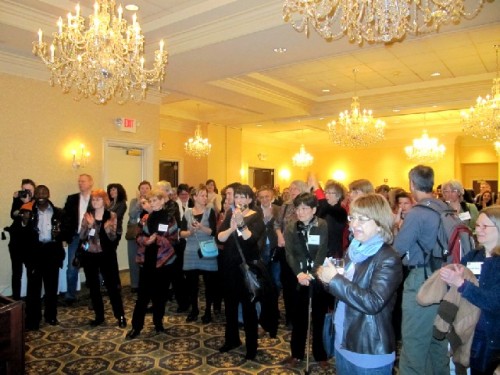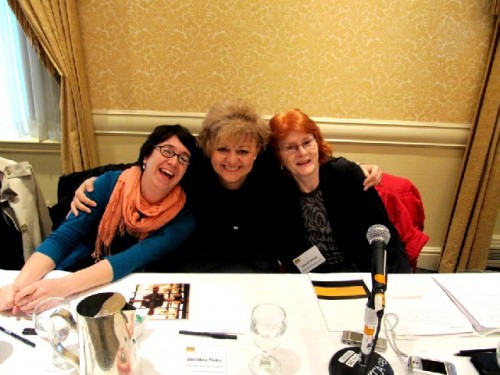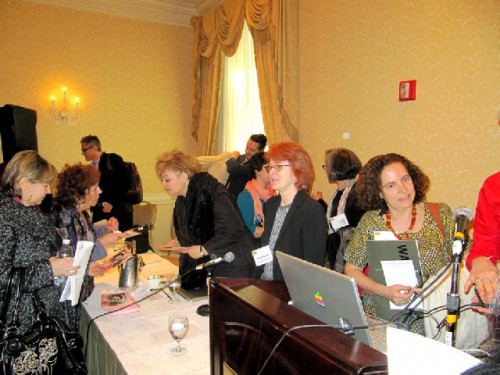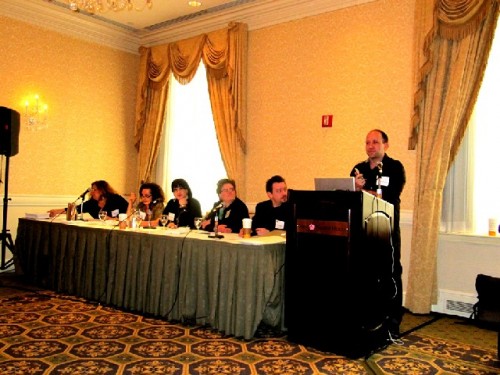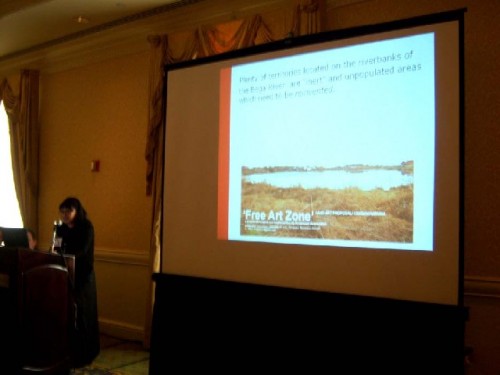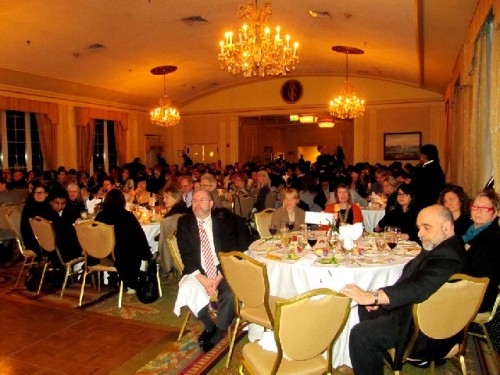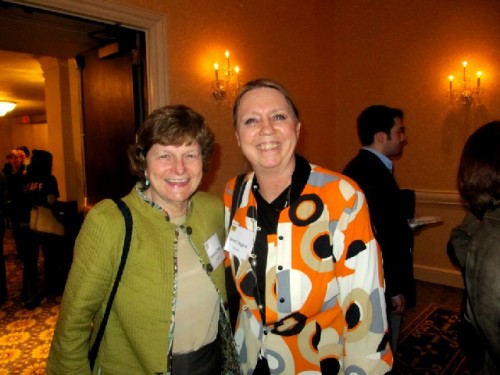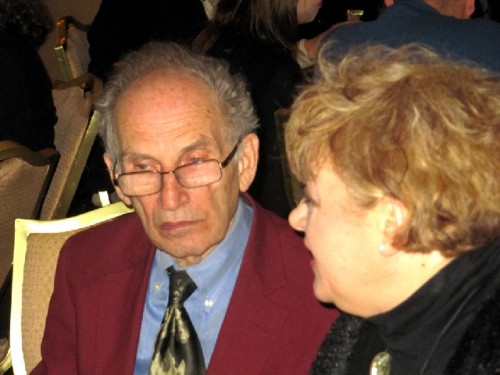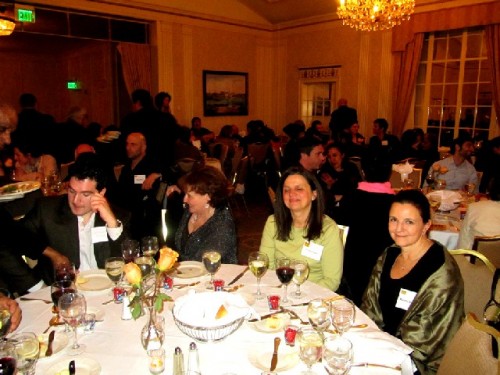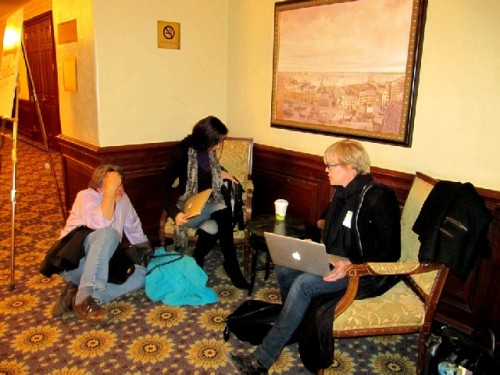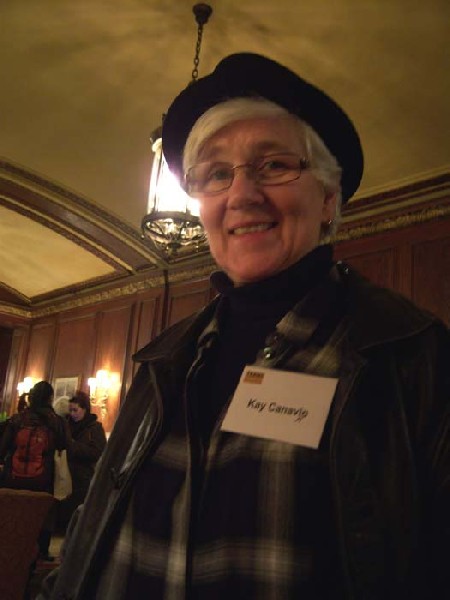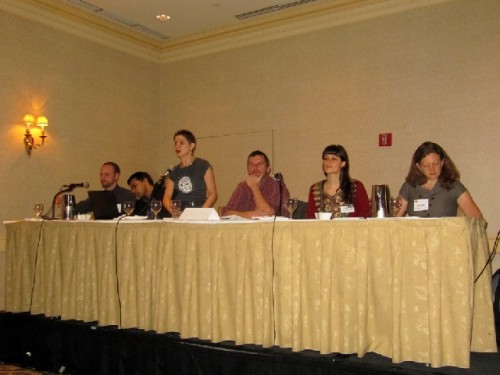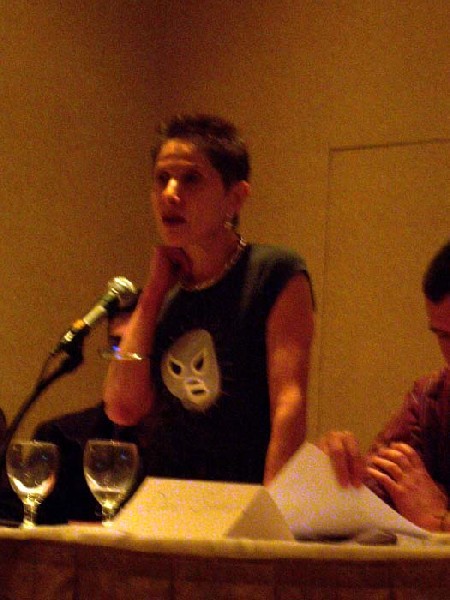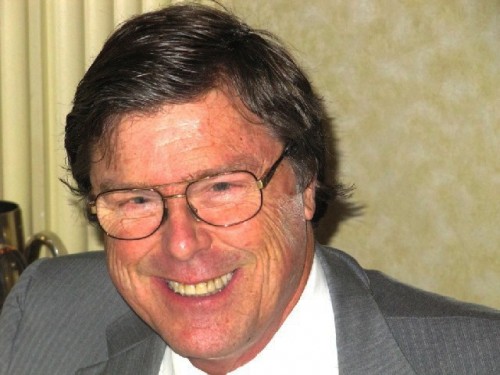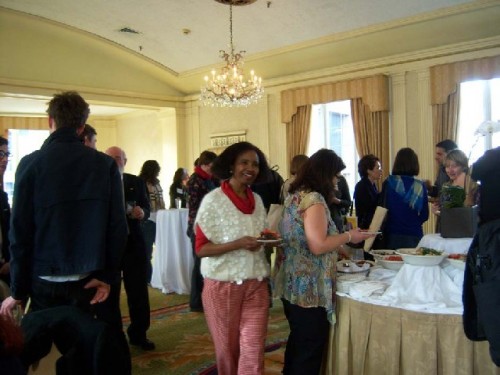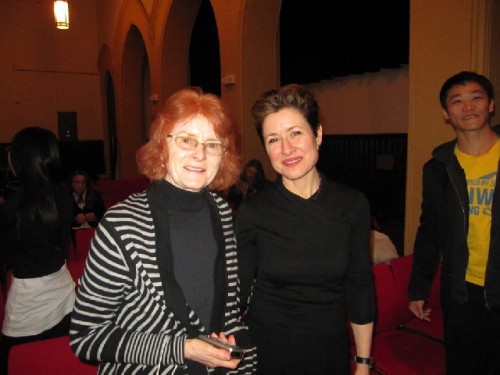International Arts Opportunities Wrap Up 2011
Conference: TransCultural Exchange - Part Two
By: Astrid Hiemer - May 03, 2011
The third conference offering International Opportunities in the Arts and titled, The Interconnected World, was presented by Mary Sherman, director of TransCultural Exchange (TCE). It was held in Boston, Massachusetts, from April 7 – 10, 2011.
Saturday, April 9: The morning started with 'Launching Your Career Internationally: Residencies as the Ultimate Networking Experience,' which I moderated. The first introduction was Dorothea Fleiss, an artist and director of the D. Fleiss East-West Artist Association in Stuttgart, Germany. She has privately sponsored a yearly symposium/residency in Carei, Romania, for more than a decade. Since then, she has also organized or co-sponsored symposia in Austria, China, France and Hungary, now even Serbia and Turkey. She spoke candidly about her experiences and choices of candidates: 'Getting an impression of a person, who will have to work within a group is important. And, the need for artist groups to also be grounded in the temporary community and to give back for their hospitality in some way.' Often, the symposium closes with an exhibition and an open invitation to the community. BFA has posted several articles in the past about Dorothea, notably about our participation in her residency project in Paraza, South of France, in 2009. That experience still resonates beautifully with us !
We also realized that most every one on this panel has had a personal or professional connection to Fleiss. - Ellen Schoen, the next speaker confirmed, that in her case, having participated at the Hovinkartano Art Center, Hauho, Finland, has taken her to five other residencies in the last two to three years and opened doors to collaboration and participation in international exhibitions. Schoen is a ceramic sculptor and has produced, on location, work that is different from her own studio work. She would use materials that were easily available there.
Amertah Perman flew in from the West Coast and presented the Red Gate Gallery’s International Artist Residency Program in Beijing, China. She spent a year there as director, whereas the program invites 60 creative individuals from many disciplines yearly. The studio apartments are located in downtown and outside of Beijing in neighborhoods, so that the visitors can also experience the environment where they live. Artists can stay from one to six months and applications are being reviewed in short intervals. Regular exhibitions of participant’s work receive media attention and the gallery has a substantial following.
Bram Arnold’s experiences in residency projects were all located in Great Britain, but included international and interdisciplinary participants. Titles that leap off the page are: ‘Schwitters 10th Anniversary Residency’ as part of The Mobile Institute; and ‘Constance’ an experimental retreat on a 112 year old wooden ship on the river Thames. Arnold has taken part in TransCultural Exchange’s world-wide projects ‘Here, There + Everywhere’ with ‘Train Journey,’ which hopefully will still be completed. Unfortunately, the train has been halted due to the current downturn in the economy.
The final speaker, Ralph Brancaccio, is an American artist, who is based in Paris and declared to work globally. Among other residencies, he participated in Fleiss’ symposia twice, several years apart. He defined the differences between residency/retreat and symposium as I paraphrase: During a residency one works individually on one’s own project. A symposium brings artists together to create in common and to connect to the community and each other for peace and a better understanding of all. Brancaccio spoke from his heart, warmly and openly inviting!
Other events on Saturday morning were: What do we mean by TransCultural Exchange? - The Selection Process - Discipline Specific vs. Multi-disciplinary Programs - Making the Case for Residencies/Exchange and Similar Programs - and Portfolio Reviews were scheduled during the last two days at the conference and were highly sought after by attendees.
‘The New Renaissance Man (sic). Doing it for Yourself: From Specialization to Multi-Tasking.’ (The panel discussion may as well have been titled, ‘Renaissance Woman,’ because as presenters and attendees, women were again in the majority at the conference.)
Susanne Mueller-Baji, who lives in Stuttgart, Germany, spoke about wearing ‘multiple hats’ and introduced various projects as artist and curator and as an independent art critic and journalist. James O’Brien, a Boston Globe correspondent, has spent time at the ‘Martha Vineyard Writers Residency.’ He reported about the many approaches it takes to be published as a writer and poet. Yannick Frank, based in Liege, Belgium, participated Thursday at the ‘World Music, the Next Generation’ evening with his piece ‘Viramundo.’ He owns his own music label and was chosen to produce the sound of the Luxembourg Pavilion at the 2009 Venice Biennale.
Elisabeth Ochsenfeld, an artist and curator, also initiated residencies and scholarships in Heidelberg and Frankfurt/Main, Germany. With her husband, Hartwig Ochsenfeld, she founded ‘Arthouse Wolfsberg’ and they invite international artists to Garana, in the Carpathian Mountains of western Romania. It is a beautiful but economically poor area, where the younger population is moving to the cities or is immigrating to Western Europe. Elisabeth joined the project: ‘Free Art Zone,’ was formed by a group of activists and artists, who are turning empty houses in a number of villages into small museums or works of art. The group is still looking for participants to move their efforts forward.
Janet Goldner used her Fulbright Fellowship to live and work during several years in Mali, West Africa. As a sculptor she collaborates with Malian artists and the experiences have deepened their relationships and inspired their works. Finally, Aysegul Kurtel, the founder and director of K2, came from Izmir, Turkey. The 20 studios are primarily occupied by younger artists. She maintains that living in a smaller city informs the artwork positively. K2 also established a documentation center and has a very active gallery program.
The afternoon sessions included: Funding the Priceless. The Funders’ Perspective: What are their Interests in Helping Artists? – Case Studies in Collaboration. Putting Creativity to Work: Artists as Collaborators in Cross-Disciplinary Teams – Charting the Unknown – The Eclipsing of Galleries’ Importance? – Studio as Factory. Ways to Acquire New Skills and Expertise in Exchange for Engaging Others in the Process - Accommodating the Other/The Relativity of Cultural Exchange: On Seeing Ourselves as Other.
Speakers of all panels and programs and their organizations or universities, which appear here only as titles, can be found at the TransCultural Exchange’s website. Please peruse.
We attended the Saturday night gala dinner in the Parker House Ball Room, a glittering and festive occasion. More than 200 people filled the room and speeches were kept at a minimum. Mary's surprise performer was Ming- cheng Huang (also known as Lawrence), who delivered a witty, delightful and naughty acrobatic sequence. As‘ Mr. Candle’ he screened a series of images, while standing straight - on his hands - or walking - on his hands - on rooftops, highways and by-ways. The audience cheered ! What a performance ! After dinner, as it is customary at the conference, we danced with high energy and ended the evening without a fire alarm incident.
On Saturday morning, John Bisbee, a sculptor, using nails in highly inventive ways, presented his work. We had seen his magnificent sculpture last year at the Denver Art Museum, but were not able to attend his talk due to a scheduling conflict.
Sunday morning started with the artists Nomeda & Gediminas Urbonas, who were presenting their 2007 Venice Biennale project: ‘Villa Lituania.’ The Urbonas engage in social, political, cross-cultural, long-term projects. Just a short context: The villa operated as the Lithuanian Embassy in Rome, until Russia invaded Lithuania during WWII. The villa was later deeded to the Soviet Union and Russia still occupies it as their embassy in Rome. To date, the Lithuanian Republic maintains that ‘Villa Lituania’ is the last occupied territory of Lithuania and the Urbanas have taken up the cause. As part of the Biennale project, they intended to fly homing pigeons from Rome to Venice. Long negotiations with Italian and Russian offices were documented as part of the project and they designed memorabilia and medals for ‘Villa Lituania.’ And, finally, 100 pigeons were released from a barge at the Canale Grande in Venice, also a complex undertaking. Many pigeons flew back to their stations nearby within a couple of days. Other pigeons actually made it home as far as Eastern European countries and Russia within two to three weeks. The project received the 2007 Venice Biennale Aperto Prize.
Other Sunday morning sessions were: Achieving Star Power, Mechanisms that Launch an Artist’s Career – The Missed Opportunity: Beyond Youth – Fast-Tracking Residencies: Symposia and /or Short-term (1 – 2 week) International Programs – and An Affordable Catalyst: Flying in the Creator instead of Their Work: Putting Artists in Residence at Theaters, Museums and other Public Institutions.
We attended the panel ‘Integrating Art and Social Good,’ which was moderated by Doris Sommer, the director of ‘Cultural Agents,’ at Harvard University. (Please refer to part one of my conference-report about the Paper Picker Press.) Marta Oslin is a Program Manager at ArtCorps, a Peace Corps for artists, which trains local organizations to maintain long term development in areas of conservation, public health and women’s rights, mostly in Central America. And, Laura Smith spoke about her three year long experiences as an ArtCorps artist in El Salvador. ‘Art can transform lives and communities, after 15 years of war,’ was one of her major points.
Nitin Swathney is a social researcher at MIT’s Art, Culture and Technology Program. He uses creative responses to conflict and crisis or ‘Art as Intervention.’ He is currently working with youths in Gaza City, with 'Voices Beyond Walls,' creating theatre productions, photography and video. The young people become quickly media savvy, have made their own short films, and can possibly find employment using their new skills. - Ian Koebner is the Founding Director of Sacred Slam. The organization holds workshops and meets with international groups or associations on location to challenge misconception, create cross-cultural exchanges and respect for diversity. Members have worked in Israel, Palestine, South Africa and the US and train the trainers. I had asked him on Saturday during a conversation: ‘How do you measure success?’ Not an easy answer, but he noted that he had learned over time, that using artistic tools can be very powerful. – The final speaker at this panel was Jose Guerreiro, of World Theater, Lisbon, Portugal, who engages young people from poor neighborhoods via performances, in order to discourage gang and drug related activities.
On Sunday afternoon, The Zamir Chorale of Boston presented at Sanders Theater in Cambridge: Middle East Harmonies: A Musical Dialogue Between Arab and Israeli Cultures. – What could be more fitting?
We attended ‘Academic Partners: Towards a Global University.’ Murray McKay, moderator and speaker gave essentially a very sophisticated show-and-tell presentation for SACI, Studio Art Centers International, in Florence, Italy. - Margaret Shiu, the director of Bamboo Curtain Studio, Hualien, Taiwan, presented the artist-run organization and spoke about their ‘University Exchange Clearing House.’ She is a member of the board of the Asia–Europe Foundation and noted the Network for International Education, funded by UNESCO. - Dr. Ilgim Veryeri-Alaca, at KOC University, offered residency, exhibition and teaching opportunities at universities in Turkey. And Dr. Maria Hirvi-Ijas, at the University of Helsinki, spoke about the free educational systems of Finland and Sweden, which include free studies abroad.
Hans Guggenheim has built academies and art schools for more than fifty years world-wide ! He and his organizations under the auspices of Projectguggenheim, have practiced for half a century, what universities are just beginning to grasp. To quote: ‘The goal of Projectguggenheim is to build art academies and art schools based on the belief that awareness of today’s art as well as in the past is the right of any artist, and especially of young artists, who live behind geographic and cultural barriers.’ His decidedly low-tech presentation was the most inspiring ! Little time was left to discuss the ‘Global University.’ A call came from Janna Longacre, professor at Massachusetts College of Art, in the audience, to form international working groups and begin exchanging and creating possibilities beyond the Satellite University and the study-year abroad.
The last two Sunday afternoon panels were: Space: Environment as Inspiration, The Residency: Rural Retreat, Utopian Revival, Urban Incubator? – And A Call to Arts: The Need for Cultural Diplomacy Today. Much more information can be found on the website of TransCultural Exchange. Please investigate the speakers, who came to Boston nationwide and from Australia, Asian and European countries. Their home bases and universities web sites have a myriad of information.
110 international or out of town speakers and 400 attendees populated the fabulous conference. Adding many volunteers, there were a total of 550 enthusiasts. The Closing Reception provided room for a few more conversations and exchanges of addresses and information, as well as speculation about the next conference and its location.
Part One

